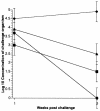Type 1 fimbriae of Salmonella enterica serovar Typhimurium bind to enterocytes and contribute to colonization of swine in vivo
- PMID: 14573666
- PMCID: PMC219564
- DOI: 10.1128/IAI.71.11.6446-6452.2003
Type 1 fimbriae of Salmonella enterica serovar Typhimurium bind to enterocytes and contribute to colonization of swine in vivo
Abstract
Salmonella enterica serovar Typhimurium strain 798 is a clinical isolate from a pig and is known to be able to cause persistent, asymptomatic infections. This strain also is known to exist in two phenotypes (adhesive and nonadhesive to enterocytes) and can switch between the two phenotypes at a rate consistent with phase variation. Cells in the adhesive phenotype are more readily phagocytosed by leukocytes than nonadhesive cells. Once in a leukocyte, adhesive-phase cells survive while nonadhesive-phase cells die. In the present study, nonadhesive mutants were obtained with the transposon TnphoA. A nonadhesive mutant was selected for study and was shown by electron microscopy not to produce fimbriae. The gene encoding the adhesin was cloned and sequenced. Based on its sequence, the adhesin was shown to be FimA, the major subunit of type 1 fimbriae. The nonadhesive mutant was attenuated in its ability to colonize both mouse and pig intestines, but remained capable of systemic spread in mice. The nonadhesive mutant was phagocytosed to the same extent as parental cells in the adhesive phase and then survived intracellularly. These results demonstrated that type 1 fimbriae were important for attachment to enterocytes and promoted intestinal colonization. However, they were not important in promoting phagocytosis or intracellular survival.
Figures



References
-
- Acha, P. N., and B. Szyfres. 1987. Zoonoses and communicable diseases common to man and animals, 2nd ed. Pan American Health Organization, Washington, D.C.
-
- Ausubel, F., R. Brent, R. E. Kingston, D. D. Moore, J. G. Seidman, J. A. Smith, and K. Struhl. 1990. Current protocols in molecular biology, vol. 1. John Wiley and Sons, New York, N.Y.
Publication types
MeSH terms
LinkOut - more resources
Full Text Sources

